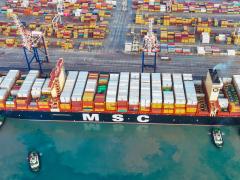FTW’s coverage of the problems on the sea trades into West Africa – serious port mismanagement, insufficient capital equipment, port congestion, lengthy delays for ships and containers, and impossible-to-keep sailing schedules among them – clearly raised a lot of steam in the SA seafreight industry. And it’s certainly not on the path to improvement, according to readers’ e-mails that have reached our mail boxes since the issue was first raised over six months ago. FTW’s recent coverage of this chaotic sea cargo market has again seen the internet wires running hot – with readers telling of their own tragic efforts to service what is a fast growing market, utterly dependent on seafreight for almost all of its imports and its few export cargoes. One such story was from Neil Robertson, owner of Robertson Freight. Speaking to FTW journalist Tersia Booyzen, he said: “Port congestion at most of these (West African) ports has resulted in various knockon effects. “The increase in port congestion surcharges and the disruption to regular liner schedules have wreaked havoc on forward planning for some of our regular exporters.” The shipping lines are equally upset at the costs of serving the West African port system. It’s a trade that Andrew Thomas, CEO of locally-based shipping line, Ocean Africa Container Line (OACL), and chairman of the SA Association of Ship Operators and Agents (Saasoa), described as “prohibitively expensive” for a line to service. And his words in FTW also raised a storm of e-mails from readers, one of which said that – along with the likes of on-going congestion, high container damage rates, missing and slow-to-return boxes, and lines having to bear the cost of returning empties – we should add “corruption”, an everyday issue in the West African sea trade. Even his letter raised an immediate response. FTW reader “Allan” agreed with the comments on corruption, but had his own complaints to add. “I sympathise with lines on the macro problems – delays,” he said. “Lagos Apapa is now a 21-day delay, and Luanda, anything between 10 and 30 days. In addition, the time taken for the lines’ containers to turn-around is astonishing. Sometimes a line can wait three-to-four months to get their empties back and evacuated . “I have yet to see a line advertise a schedule at the start of its West Africa trip and not lose at least two/ three weeks in its anticipated turnaround.” Thomas confirmed this, telling FTW that his line reckons that it loses about 20-25% of its annual voyage time on the Luanda run. And it’s a problem that FTW readers all say is certainly not getting any better – despite West African governments’ public relations promises of all sorts of planned investment in port development.












